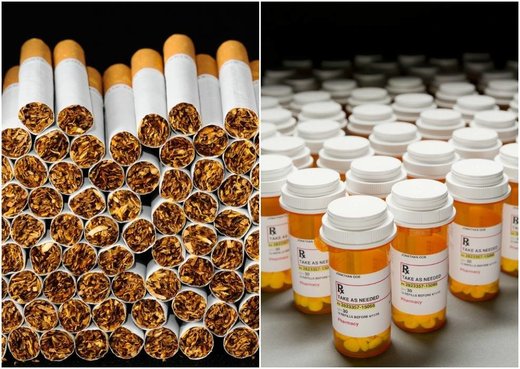The findings came from the Substance Abuse and Mental Health Services Administration (SAMHSA). The report shows that 38% of Americans used prescription painkillers in 2015, while 31% used cigarettes, cigars or smokeless tobacco.
Those numbers are especially noteworthy because, according to the Centers for Disease Control and Prevention (CDC), more people died from prescription painkillers than homicide in 2014.
CDC data has also found that opioid overdose deaths climbed from about 5,500 in 2002 to just over 12,000 in 2014.
The widespread use of prescription painkillers in the U.S. is no longer a secret. A 2008 study, published in the Pain Physician Journal, showed that Americans consume 99% of the global supply of hydrocodone and 80% of the global opioid supply.
Comment: A nation in pain: Americans consume 80% of all opioids sold globally
Many Americans would argue that the U.S. is the greatest nation on Earth, a beacon of freedom and hope for the rest of the world to emulate. But when it comes to mental and physical quality of life here in the States, America appears to rank near the bottom, as evidenced by the nation's massive and growing addiction to pharmaceutical drugs and painkillers.
Though it often isn't talked about, Americans consume most of the pharmaceutical drugs produced for the entire world, even though we represent a mere 5 percent of the global population. And when it comes to painkillers, Americans consume a staggering 80 percent of the global supply, with doctors prescribing more than 259 million scripts for painkillers annually.
These figures suggest that, behind the facade, Americans as a whole suffer from far more pain and disease than much of the rest of the world. Either that, or many Americans have become so depressed and hopeless that the only way they can cope with living is to constantly medicate themselves, a reality that seems to be reflected in the latest data sets.
The new SAMSHA report did not indicate what percentage of people misused prescription painkillers. SAMHSA's definition of misuse includes any use of painkillers in a manner not as directed by a doctor—which can range from taking these substances at higher doses or longer periods of time than recommended, to using them for the sole purpose of getting high.
It's also unclear whether the current numbers are an increase or decrease over previous years, because questions regarding prescription drug use were only recently added to the National Survey on Drug Use and Health, the Washington Post's Christopher Ingraham noted.
Pharmaceutical companies have been shown to play a direct role in this widespread use. A joint investigation released this month by the Center for Public Integrity and the Associated Press revealed that pro-painkiller groups outspend groups pushing for painkiller restrictions by 200 to 1.
Some of these companies have even engaged in illegal behavior to promote sales of the drugs. Purdue Pharma, the maker of OxyContin, pleaded guilty in 2007 to misleading doctors and regulators about the drug's high potential for abuse.
Comment: How the American opiate epidemic was started by the Purdue Pharma company
Beginning around 1980, one of the more significant trends in pain pharmacology was the increased use of opioids for chronic non-cancer pain. Like other pharmaceutical companies, Purdue likely sought to capitalize on the abundant financial opportunities of this trend. The logic was simple: While the number of cancer patients was not likely to increase drastically from one year to the next, if a company could expand the indications for use of a particular drug, then it could boost sales exponentially without any real change in the country's health demography.
This was indeed one of OxyContin's greatest tactical successes. According to "The Promotion and Marketing of OxyContin," from 1997 to 2002 prescriptions of OxyContin for non-cancer pain increased almost tenfold. Meanwhile, in 1996 the FDA approved an 80mg version of the pill; four years later it approved a 160mg tablet. According to the FDA's "History of OxyContin: Labeling and Risk Management Program," higher dosages were approved specifically for opioid-tolerant patients.
These high-milligram pills were probably one of biggest reasons that OxyContin became such a popular street drug. Recreational users and addicts could crush, sniff, and inject the pill for a powerful high that, as promised, lasted over eight hours. The euphoric effects and potential for abuse were comparable to heroin. But clearly doctors and pharmacies never drew the ghastly parallel. Why?
Earlier this year, the CDC released new guidelines regarding painkillers in response to excessive dispensing of them. Its data showed that doctors wrote 82.5 opioid prescriptions per 100 people in 2012, enough for every American adult to have their own bottle.




Reader Comments